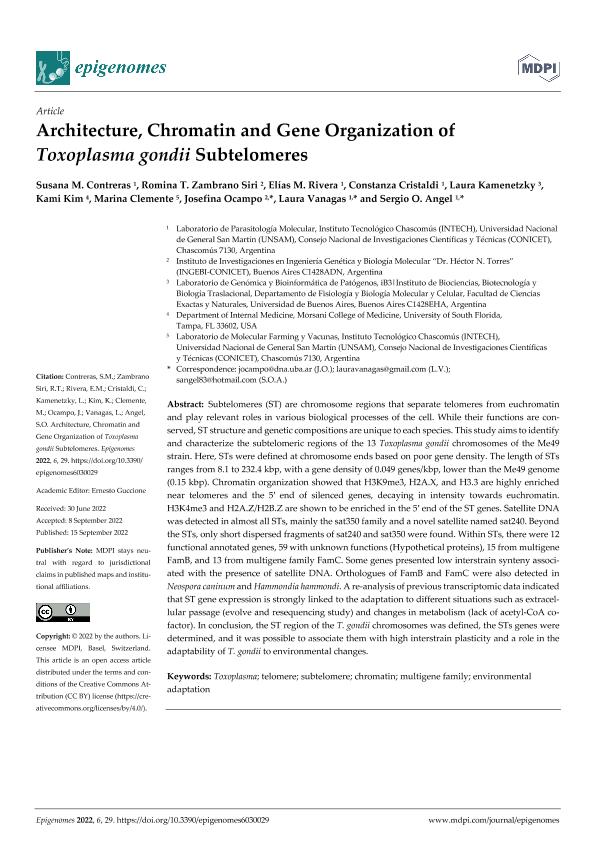Artículo
Architecture, chromatin and gene organization of Toxoplasma gondii subtelomeres
Contreras, Susana Marisol ; Zambrano Siri, Romina T.; Rivera, Elias Maximiliano
; Zambrano Siri, Romina T.; Rivera, Elias Maximiliano ; Cristaldi, Constanza
; Cristaldi, Constanza ; Kamenetzky, Laura
; Kamenetzky, Laura ; Kim, Kami; Clemente, Marina
; Kim, Kami; Clemente, Marina ; Ocampo, Josefina
; Ocampo, Josefina ; Vanagas, Laura
; Vanagas, Laura ; Angel, Sergio Oscar
; Angel, Sergio Oscar
 ; Zambrano Siri, Romina T.; Rivera, Elias Maximiliano
; Zambrano Siri, Romina T.; Rivera, Elias Maximiliano ; Cristaldi, Constanza
; Cristaldi, Constanza ; Kamenetzky, Laura
; Kamenetzky, Laura ; Kim, Kami; Clemente, Marina
; Kim, Kami; Clemente, Marina ; Ocampo, Josefina
; Ocampo, Josefina ; Vanagas, Laura
; Vanagas, Laura ; Angel, Sergio Oscar
; Angel, Sergio Oscar
Fecha de publicación:
15/09/2022
Editorial:
Multidisciplinary Digital Publishing Institute
Revista:
Epigenomes
ISSN:
2075-4655
Idioma:
Inglés
Tipo de recurso:
Artículo publicado
Clasificación temática:
Resumen
Subtelomeres (ST) are chromosome regions that separate telomeres from euchromatin and play relevant roles in various biological processes of the cell. While their functions are conserved, ST structure and genetic compositions are unique to each species. This study aims to identify and characterize the subtelomeric regions of the 13 Toxoplasma gondii chromosomes of the Me49 strain. Here, STs were defined at chromosome ends based on poor gene density. The length of STs ranges from 8.1 to 232.4 kbp, with a gene density of 0.049 genes/kbp, lower than the Me49 genome (0.15 kbp). Chromatin organization showed that H3K9me3, H2A.X, and H3.3 are highly enriched near telomeres and the 5′ end of silenced genes, decaying in intensity towards euchromatin. H3K4me3 and H2A.Z/H2B.Z are shown to be enriched in the 5′ end of the ST genes. Satellite DNA was detected in almost all STs, mainly the sat350 family and a novel satellite named sat240. Beyond the STs, only short dispersed fragments of sat240 and sat350 were found. Within STs, there were 12 functional annotated genes, 59 with unknown functions (Hypothetical proteins), 15 from multigene FamB, and 13 from multigene family FamC. Some genes presented low interstrain synteny associated with the presence of satellite DNA. Orthologues of FamB and FamC were also detected in Neospora caninum and Hammondia hammondi. A re-analysis of previous transcriptomic data indicated that ST gene expression is strongly linked to the adaptation to different situations such as extracellular passage (evolve and resequencing study) and changes in metabolism (lack of acetyl-CoA cofactor). In conclusion, the ST region of the T. gondii chromosomes was defined, the STs genes were determined, and it was possible to associate them with high interstrain plasticity and a role in the adaptability of T. gondii to environmental changes.
Palabras clave:
TOXOPLASMA
,
SUBTELOMEROS
,
CROMATINA
,
ARQUITECTURA
Archivos asociados
Licencia
Identificadores
Colecciones
Articulos(CCT - LA PLATA)
Articulos de CTRO.CIENTIFICO TECNOL.CONICET - LA PLATA
Articulos de CTRO.CIENTIFICO TECNOL.CONICET - LA PLATA
Articulos(IIB-INTECH)
Articulos de INST.DE INVEST.BIOTECNOLOGICAS - INSTITUTO TECNOLOGICO CHASCOMUS
Articulos de INST.DE INVEST.BIOTECNOLOGICAS - INSTITUTO TECNOLOGICO CHASCOMUS
Articulos(INGEBI)
Articulos de INST.DE INVEST.EN ING.GENETICA Y BIOL.MOLECULAR "DR. HECTOR N TORRES"
Articulos de INST.DE INVEST.EN ING.GENETICA Y BIOL.MOLECULAR "DR. HECTOR N TORRES"
Citación
Contreras, Susana Marisol; Zambrano Siri, Romina T.; Rivera, Elias Maximiliano; Cristaldi, Constanza; Kamenetzky, Laura; et al.; Architecture, chromatin and gene organization of Toxoplasma gondii subtelomeres; Multidisciplinary Digital Publishing Institute; Epigenomes; 6; 3; 15-9-2022; 1-22
Compartir
Altmétricas



